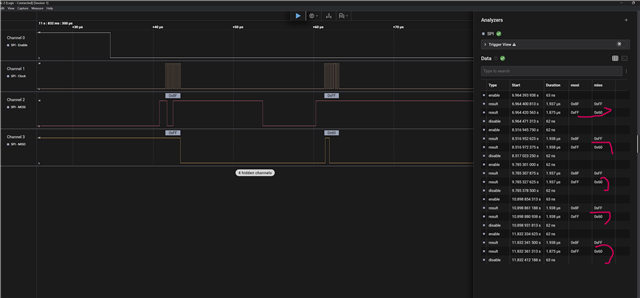Hey everyone. I am having an issue reading the WHO_AM_I register from the stm lsm6dsv16x.
I am using the spi1 configuration as shown in the academy classes. I have very short cables.
The issue I get is. I am constantly reading 0x60, but I should be reading 0x70.
I also see people have similar issues from this stm link
community.st.com/.../810200
I tested in multiple configurations in Mode 0 and 3 ( supported only by lsm6dsv16x). But for some reason I could never get the frist bit correct. I am following similar code you guys have for the spi read on the academy course, but still get 0x60.
the boards I am using is the lsm6dsv16x sparkfun breakout board( I made sure it is configured for spi) and the nrf52840dk

&spi2 {
compatible = "nordic,nrf-spim";
status = "okay";
cs-gpios = <&gpio0 30 GPIO_ACTIVE_LOW>;
pinctrl-0 = <&spi2_default>;
pinctrl-1 = <&spi2_sleep>;
pinctrl-names = "default", "sleep";
lsm6dsv16x: lsm6dsv16x@0 {
status = "okay";
compatible = "zephyr,custom-lsm6dsv16x";
reg = <0>;
spi-cpol;
spi-cpha;
spi-max-frequency = <4000000>;
int1-gpios = <&gpio1 9 (GPIO_PULL_DOWN | GPIO_ACTIVE_HIGH)>;
int2-gpios = <&gpio0 3 (GPIO_PULL_DOWN | GPIO_ACTIVE_HIGH)>;
};
};
&{/aliases} {
imu0 = &lsm6dsv16x; /* flip to &imu_icm to build with the other driver */
};
&pinctrl {
i2c0_default: i2c0_default {
group1 { psels = <NRF_PSEL(TWIM_SCL, 0, 27)>,
<NRF_PSEL(TWIM_SDA, 0, 5)>; };
};
i2c0_sleep: i2c0_sleep {
group1 { psels = <NRF_PSEL(TWIM_SCL, 0, 27)>,
<NRF_PSEL(TWIM_SDA, 0, 5)>;
low-power-enable; };
};
spi2_default: spi2_default {
group1 { psels = <NRF_PSEL(SPIM_SCK, 0, 28)>,
<NRF_PSEL(SPIM_MOSI, 0, 29)>,
<NRF_PSEL(SPIM_MISO, 0, 31)>;
};
};
spi2_sleep: spi2_sleep {
group1 { psels = <NRF_PSEL(SPIM_SCK, 0, 28)>,
<NRF_PSEL(SPIM_MOSI, 0, 29)>,
<NRF_PSEL(SPIM_MISO, 0, 31)>;
low-power-enable;
};
};
};
int32_t platform_read(void *handle, uint8_t reg, uint8_t *bufp, uint16_t len)
{
const struct lsm6dsv16x_config *cfg = handle;
uint8_t tx_buffer = reg | 0x80; // Set MSB to indicate read
uint8_t rx_buffer[len + 1]; // Temporary buffer to receive extra byte
struct spi_buf tx_bufs[] = {
{ .buf = &tx_buffer, .len = 1 },
};
struct spi_buf rx_bufs[] = {
{ .buf = rx_buffer, .len = len + 1 },
};
struct spi_buf_set tx_set = { .buffers = tx_bufs, .count = 1 };
struct spi_buf_set rx_set = { .buffers = rx_bufs, .count = 1 };
int ret = spi_transceive_dt(&cfg->spi, &tx_set, &rx_set);
if (ret < 0) {
return ret;
}
memcpy(bufp, &rx_buffer[1], len); // Skip dummy byte
return 0;
}


